Wednesday, July 17, 2024. I was up at 1:56 a.m. and took this photo in the land of the midnight sun. At home in Michigan in the summer, it’s dark at 1:56 a.m. in the summer.
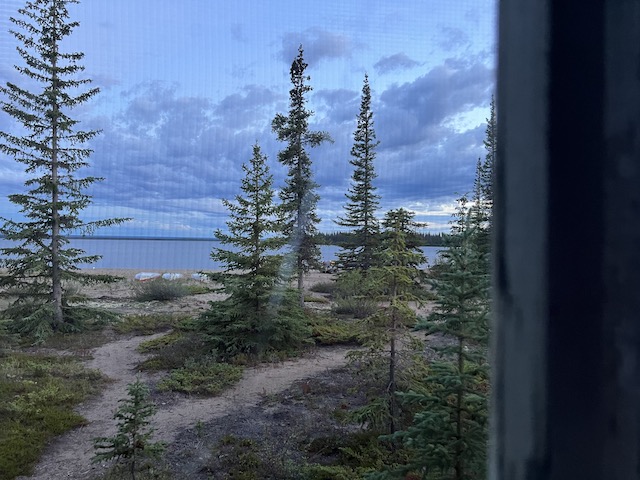

One think I like about fishing trips is that sometimes you meet really nice people and you want to help them catch fish. Meet Ina and Brent from Saskatchewan. They are school teachers, and when they learned a former student Matt, was going to be a guide at the Trophy Lodge, they decided to sign up for a week to fish with him. I met Ina as we loaded up on the shuttle at the motel–both of us happy that another woman was going to camp. After a couple of breakfasts and dinners together I knew I’d found some great people.
So, when we learned that Ina, Brent and Matt were going to the Croquechet River (or however it’s spelled), we gave them our red Whopper Plopper–the lure Mark had caught pike with on nearly every cast. In exchange, they told us where they’d caught grayling the day before.

It would come to pass that perhaps Mark, Manny and I didn’t pay full attention to the details they provided.
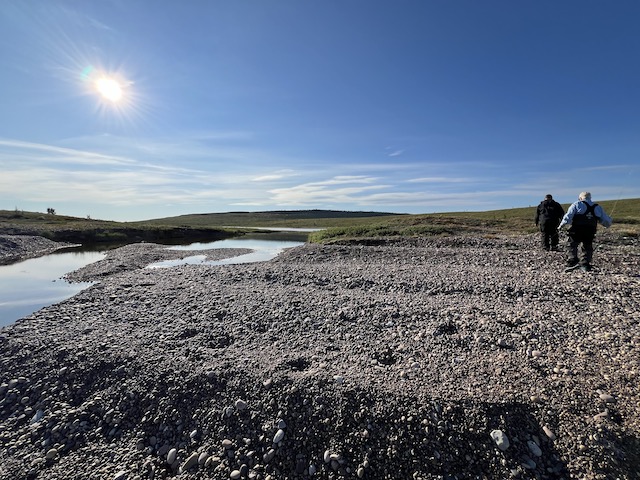
What we heard Ina, Brent or Matt say is that they caught grayling in this pond that might have emptied out into the lake had it not been blocked from doing so. Manny thought he knew exactly where they were talking about, and we arrived at the location above. We walked along the shoreline scratching our heads because we saw no fish of any kind in the shallows and no movement of any kind to suggest there were fish anywhere in the pond. So, we got back into the boat, went to where the pond turned left in the photo above, walked from the shore to the pond again and it was muddy and mucked up along the edges of the pond. Nobody would fish from there.

While we saw no fish in the pond, I looked up just in time from taking a leak to see this bird fly by. I don’t normally take my camera with me when I’m just taking a leak and scouting around, but clearly I should have because the photo to the right is a screen shot from a video taken on my cell phone, and the bird turned out to be a parasitic jaeger, or Arctic skua, which preys mainly on birds and their eggs. They will also eat mammals, berries, and carrion. On they ocean, they will harass other seabirds until they give up their catch.
Lesson learned: take camera with zoom lens when taking a leak break.
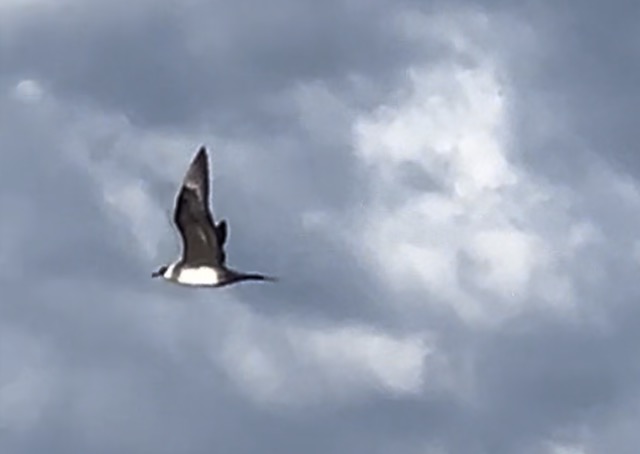
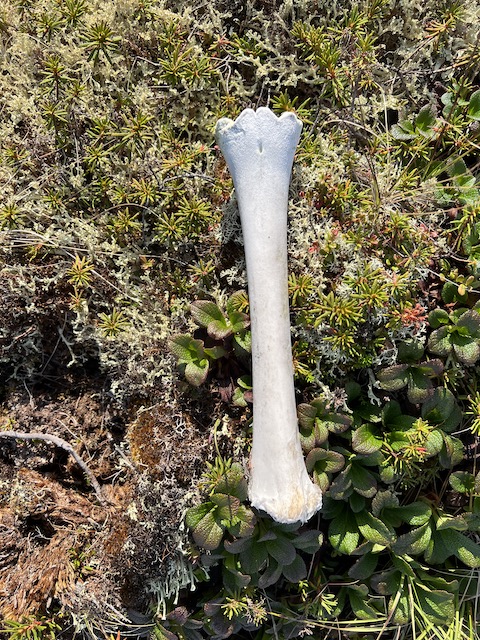
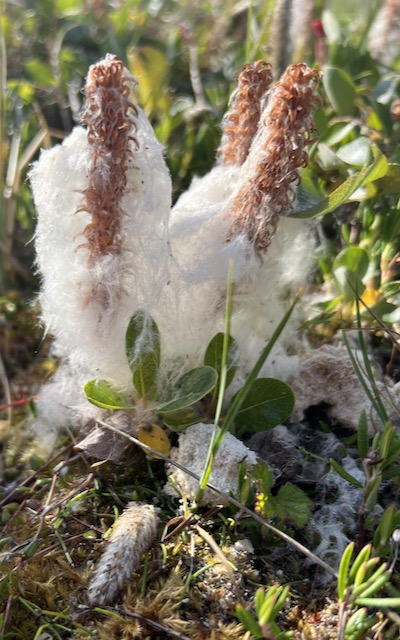
While on shore I used my phone to take a few other photos, including the bone, the plant above, right, and the amazing landscape that is the tundra.
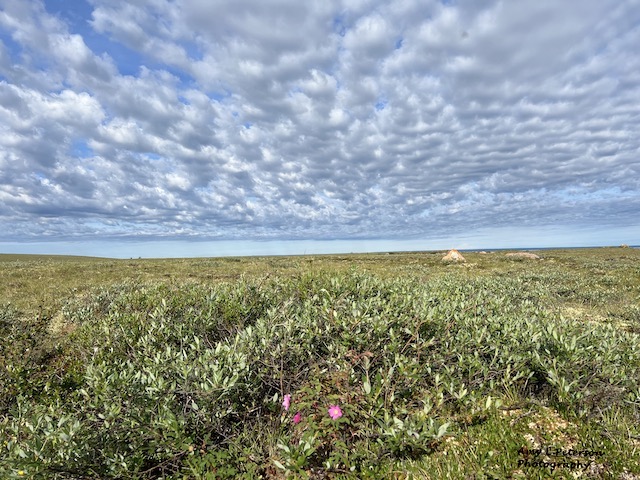
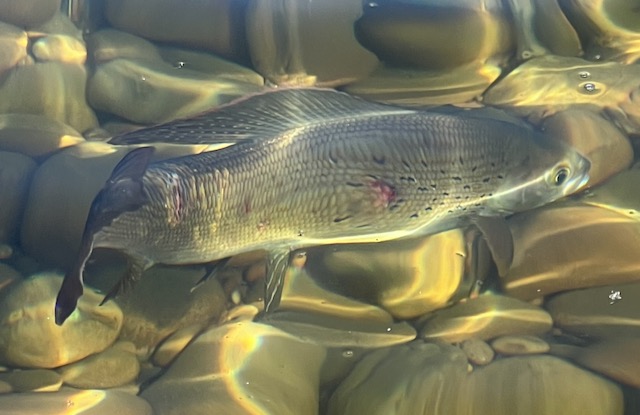
What we finally realized is that where Ina and Brent caught their grayling is in Great Bear Lake near the pond. All we had to do is go a few feet off shore near the first spot we’d stopped at and cast a small lure called a spinner, and we caught grayling after grayling. Grayling have long dorsal fins, and the one above has pink on its long dorsal and is a female; the one on the right has blue on its dorsal and is a male. The female looked like she’d been attached by something in what is a cruel, fish-eat-fish world.
Check out this video of a grayling on the line.
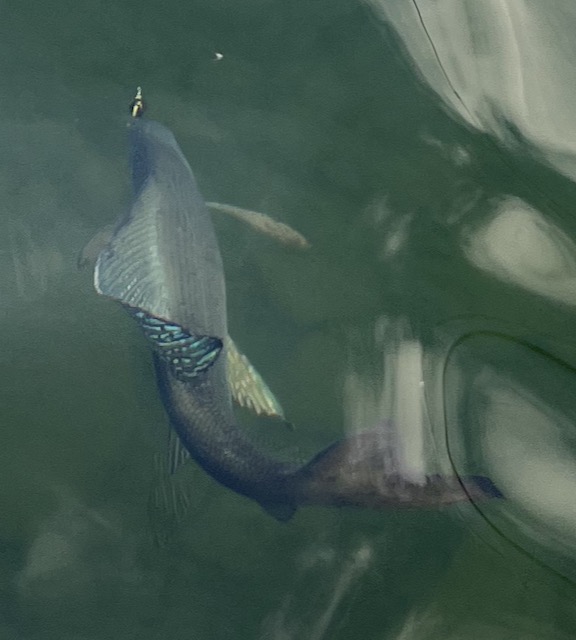
I will note here that we had about 30 small lures for catching grayling; we used two lures and caught plenty of grayling.
We moved on to do lake trout fishing, and it took until almost noon before Mark landed this beautiful fish.
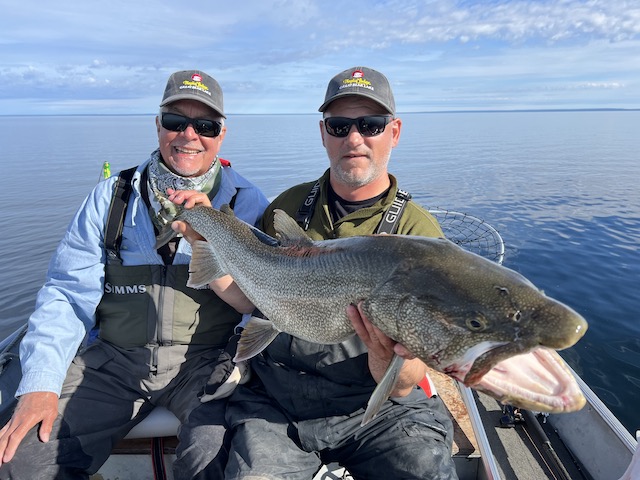
Meanwhile, I was visited by this insect, a muscid fly. They apparently feed on nectar and flowers, which means I must have smelled pretty good.
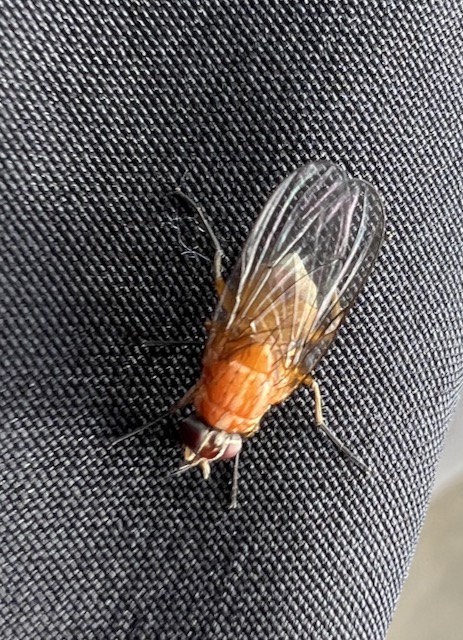
Somewhere during the afternoon, I saw what looked like a common loon. I almost didn’t take photos of it, but I thought I best “just in case.” Only later, after I’d downloaded the photos at home did I realize the bird was not a common loon, but a yellow-billed loon. These loons–also called white-billed divers–breed only in the arctic and are an internal species of concern, considered to be one of the 10 rarest birds that regularly breeds on the mainland U.S (says the National Park Service).
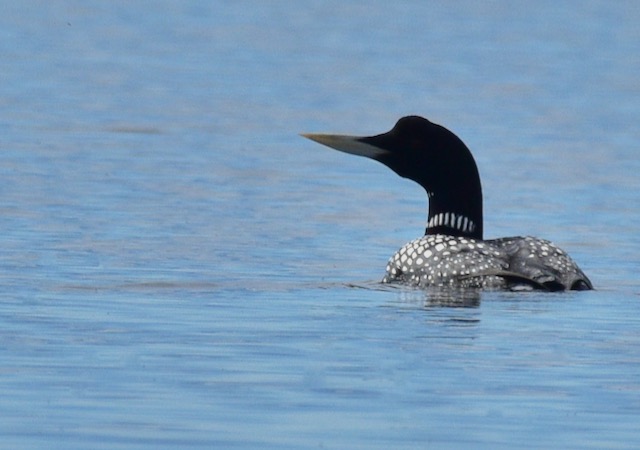

On shore was what I believe is a baby Brewer’s Blackbird which could take a leak on shore. But since I couldn’t, I asked the guys to look the other way as I squatted over a coffee can Manny kept in the front of the boat. A first for me, but all fine since Mark’s seat blocked the bow of the boat. I did learn–ladies–that it’s easier to lower and raise sweats/leggings than pants with a button and zipper.
The thing about being a woman is that the shoreline of a fishing trip may not be conducive for getting to shore to take a leek. That turned out to be the case this afternoon–the shoreline was so rocky, that even after checking out a large spanse of shoreline, there was no place to land.
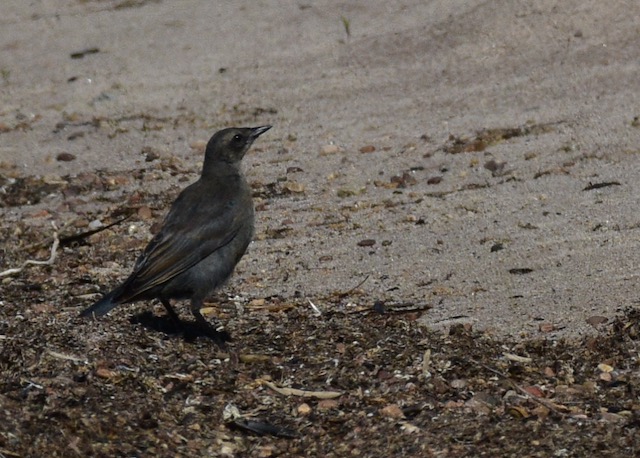

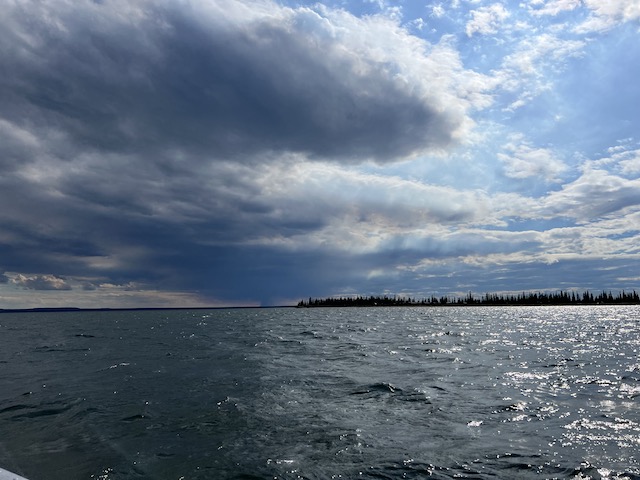
We had nothing to show for the rest of the afternoon, trolling hither and yon. As we headed back the weather changed on us quickly: the photo to the left was taken at 3:41 pm. The photo to the right was taken at 3:57 p.m. It looked pretty gnarly by the time we got back.

Shortly after we got back, we heard that Matt, the guide, shown to the right, had seen fins swirling at the surface of the water at one point during the day, fins he said were grayling. He had tied on the Whopper Plopper we’d given to Ina and Brent, and threw the Whopper Plopper–a bait that makes propeller-like noises across the surface of the water–and caught a 39-pound trout. On light (10-pound) line. Amazing.
Apparently, Matt later tossed the Whopper Plopper as intended towards the pike in the Crotch-ochet River…and lost the lure to a toothy pike.
Afterwards, Ina and I shot some billiard and discovered we were both pretty competitive. We had a good time.
We returned early and enjoyed a cold beer. Trout fishing had been pretty lousy, but seeing two birds I’d never seen before made up for it.

During my evening walk around the lodge property I stumbled upon this young yellow-rumped warbler, which I’d seen and photographed earlier in the week. Still, this one was cute, so I had to take its photo.
I also took this video to show how squishy the tundra is...and why I wore hiking books on my walk.
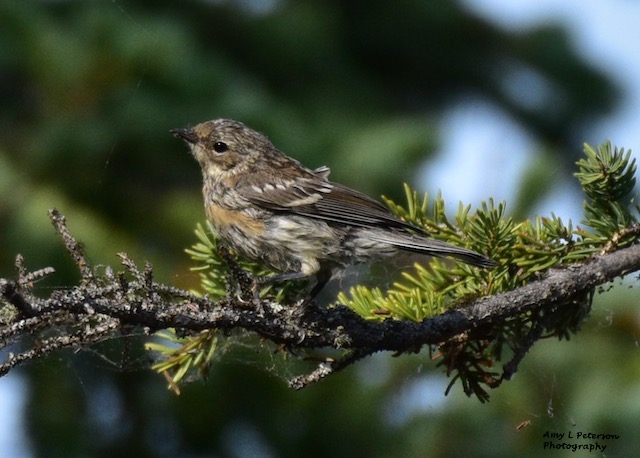
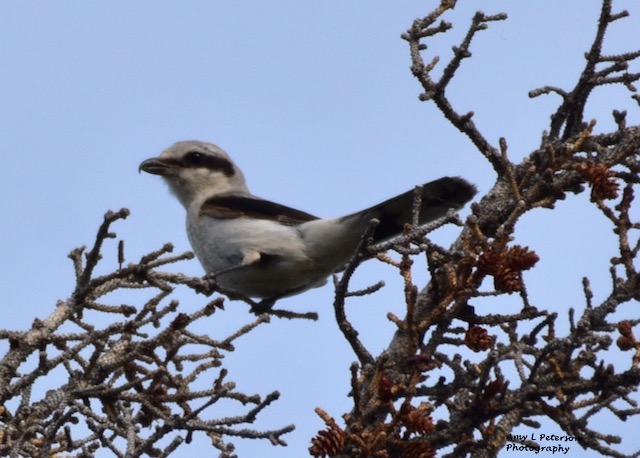
I also saw a loggerhead shrike, which was my first. This bird is nicknamed the “butcher bird.” This bird preys on pretty much anything that moves–they dive onto their play, hover over prey and dive, and will also hunt from the ground, flashing their wings to startle prey out of hiding. They also impale large pretty onto thorns, barbed wire or forked branches of trees. They will store prey to get through the winter when prey is scarce. This bird’s population has been declining for a long time–practically disappearing from the NE US–such that they are on a list of Common Birds in Steep Decline per Cornell University’s All About Birds web site.
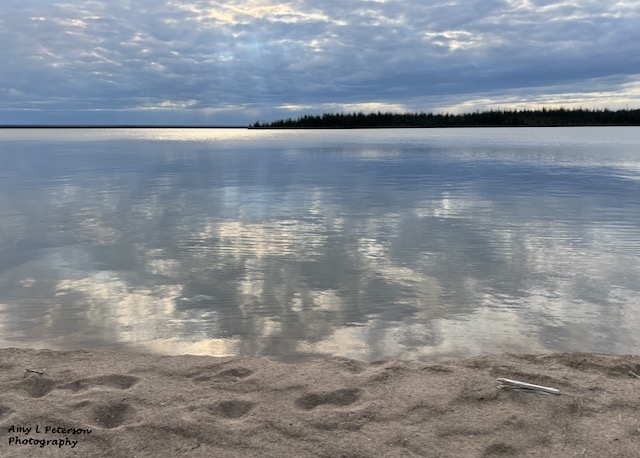
Just another shot of the beautiful Great Bear Lake.
They rolled out the barrels for us at the Trophy Lodge…or a delivery occurred while we were out fishing.

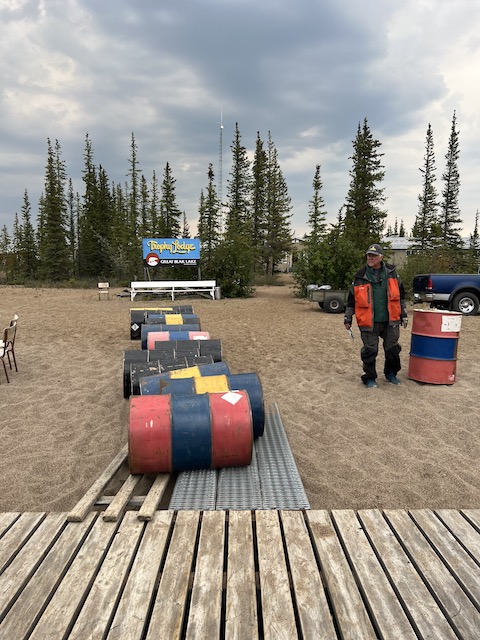
It was a flat calm evening, so at 10 p.m. or so, Mark and I took a moment to take a selfie before we went fishing, hoping the late evening bite would generate a big lake trout. Manny offered to take us out since the bite during the day was terrible.
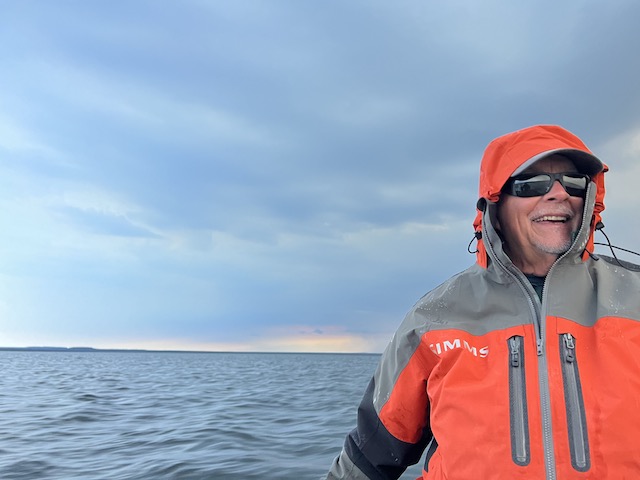

We fished near the lodge in a spot called the Airport, and trolled for an hour without any hits. The sky got darker and darker, and suggested rain was coming our way. When we saw lightning in the clouds, Manny raced us back to shore.
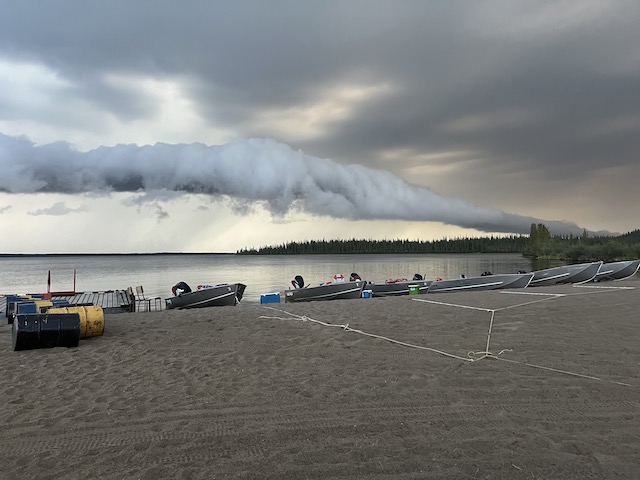
Mark went inside to get ready for bed. It was 11:07 p.m. and I stayed out with Manny and witnessed the formation of this long, skinny cloud. It was mostly white as it approached, but behind it was gray, if not black. Meanwhile, lightning continued to flash to the far right of the photo. Manny walked back to the boats to make sure they were tied down. In the foreground are anchored lines that the boats are all tied to. Check out this video.


Suddenly, the white cloud dissipated into nothing but black, the wind kicked up and Manny yelled “Run!” We ran toward the lodge and he yelled behind me to get inside, that he had to go get the guides, that the wind was a rare wind and might flood the boats. I ran inside, walked quickly down the hall to our room, and looked out the window.
I took the two photos above at 11:09 p.m., within a few seconds of each other. I’d never seen a cloud change so quickly. And I couldn’t recall when I was last outside to witness absolute stillness change into gale winds and white caps.
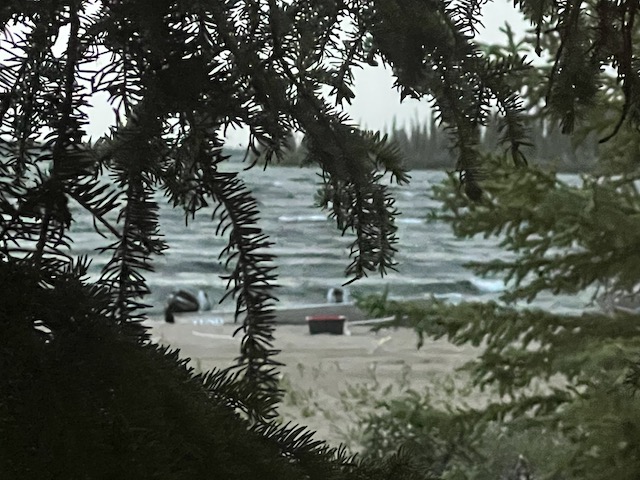

The above photos were taken at 11:15 and 11:16 p.m.. To the right, Manny and the other guides moved boats as best they could to keep them from floating away or getting swamped. I could only imagine how hard that was, especially with sand likely blowing in their faces.
By 11:34, the lake had calmed down again. This shot was taken outside and to the left of where the guides were bailing boats. After this, I went to bed, blissfully unaware that the guides were working their butts off until 2 a.m. , bailing boats, removing sand from boats, and getting the boats ready for us guests to go fishing tomorrow.
